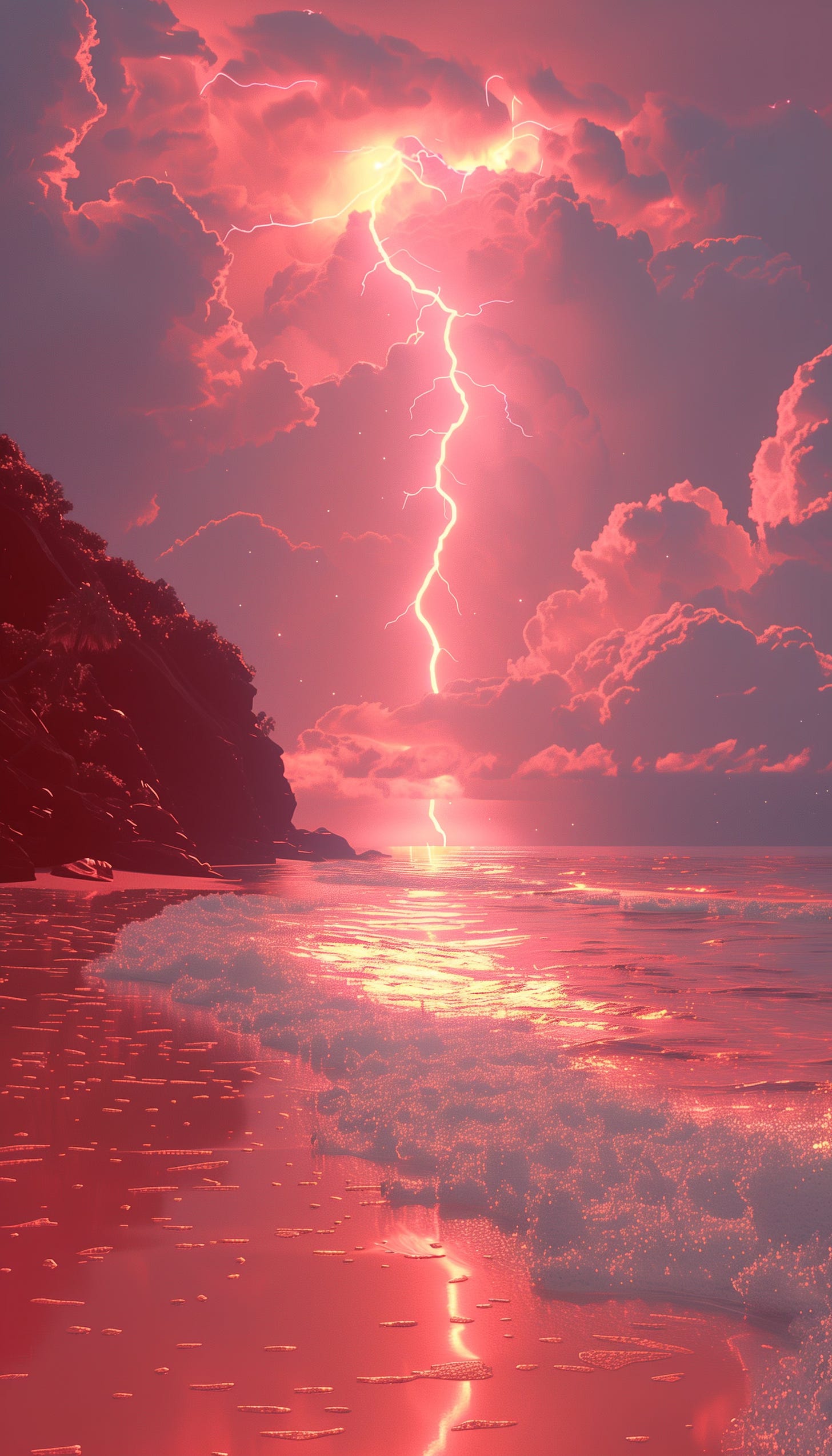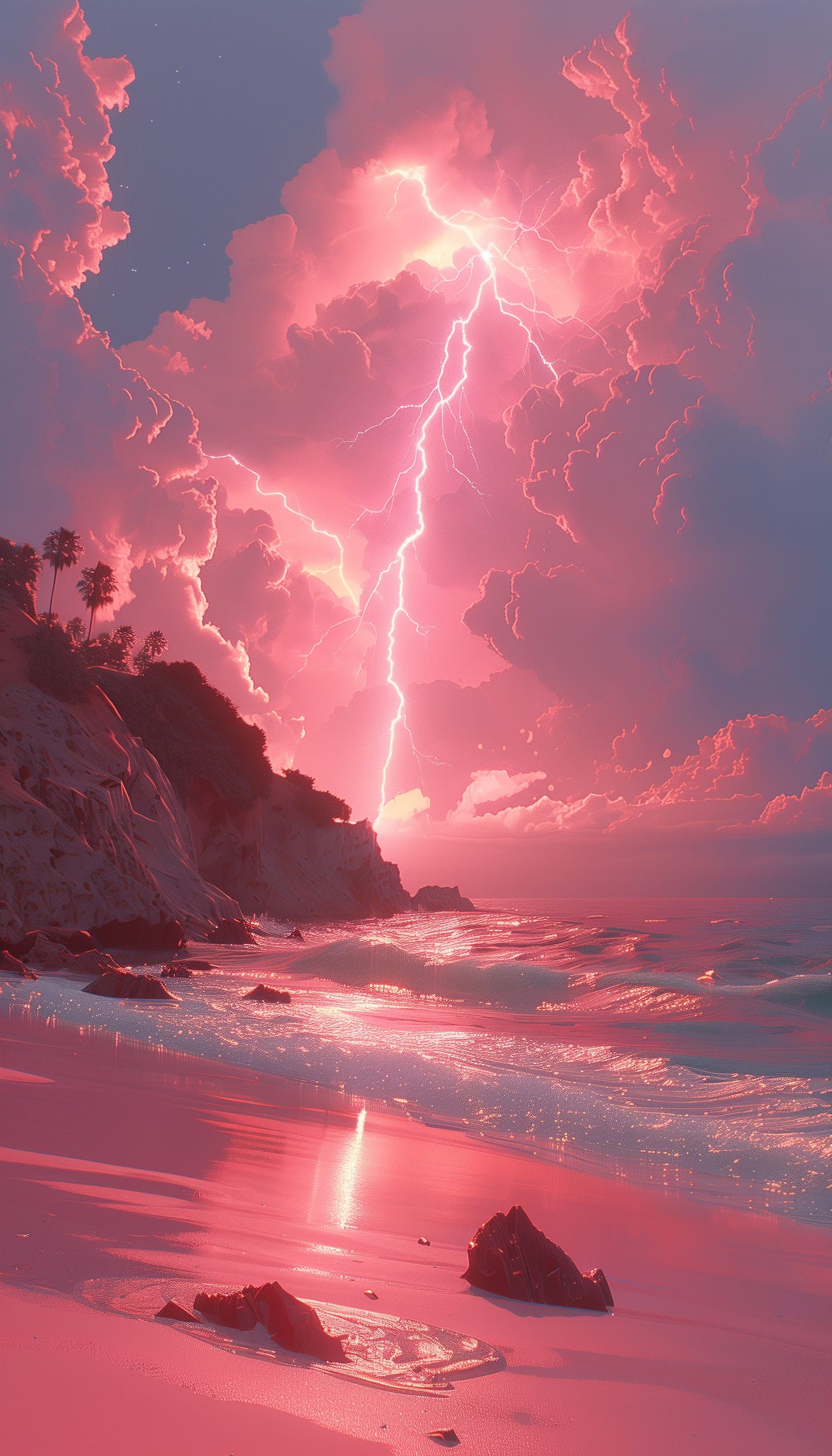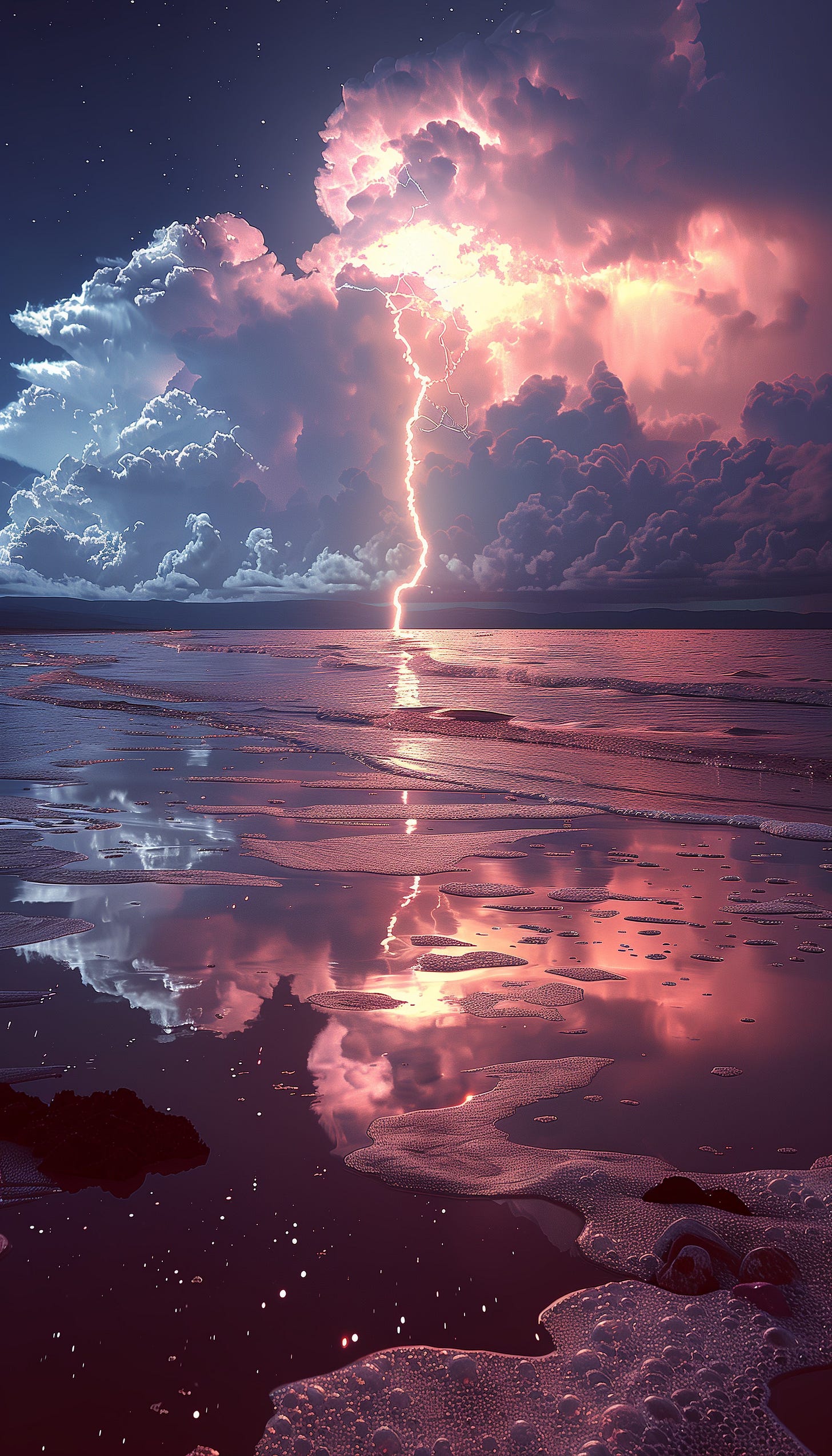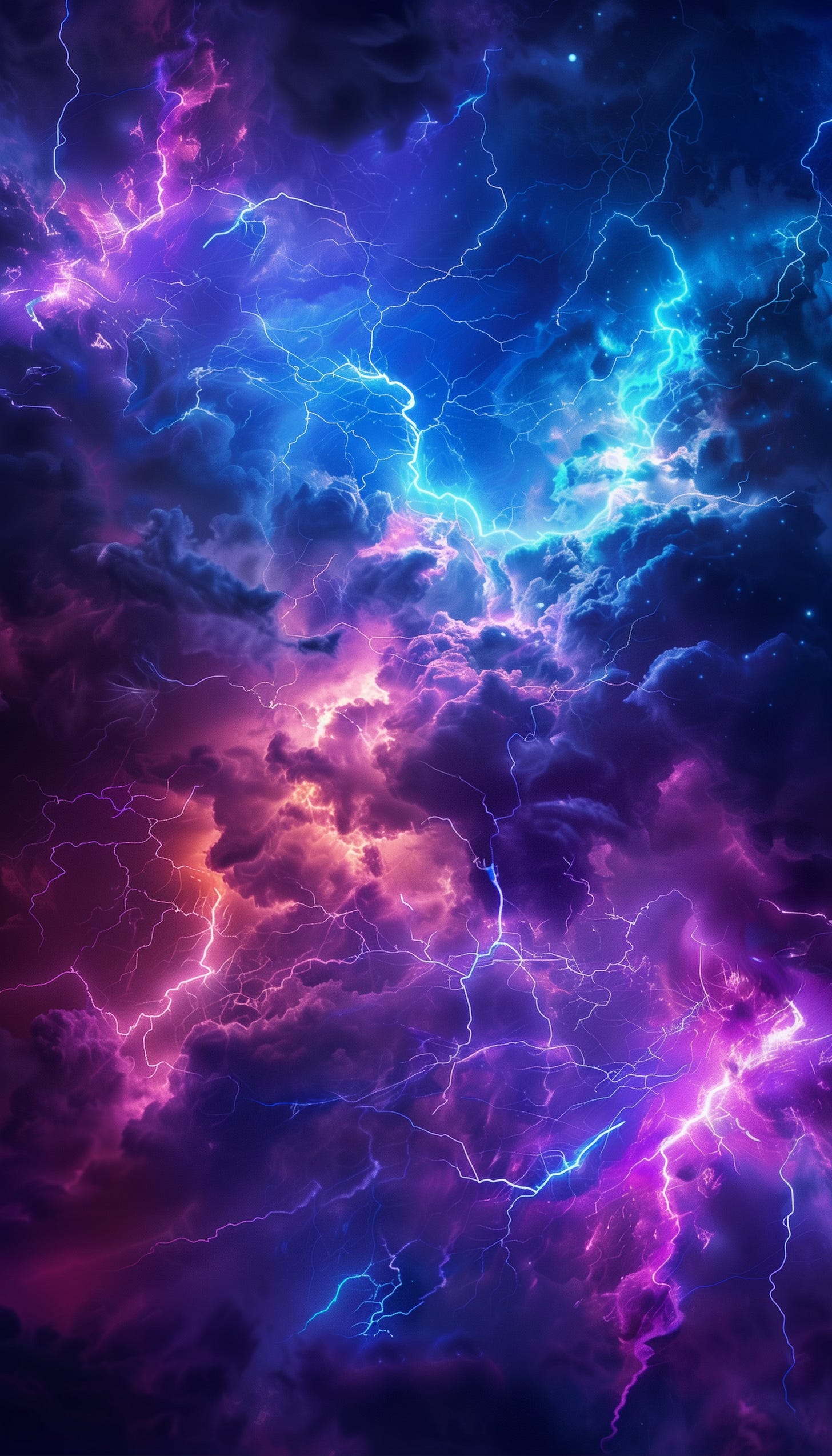Lightning, a powerful and awe-inspiring natural phenomenon, has captivated human attention for centuries. Recently, lightning took out my WiFi internet at home, and as I parked at Panera for their WiFi, my eyes landed on a patch of sky where the most magnificent pink lightning strike appeared and inspired this post. This moment brought back fond memories from my childhood when my dad, brother, and I would go to the third floor of our turn-of-the-century house in St. Louis City. We had a covered porch where we would lay on cots with blankets and watch summer thunderstorms. I loved the warm mist that would penetrate the screen window, making the air feel so alive. The light show, with deep rumbling bass echoing throughout the connected neighborhoods and buildings, combined with the sounds of crickets and the soft tapping of rain on the roof, brick patio, and grass below, was so enchanting and magical—especially for a child to experience. From its dazzling displays during thunderstorms to its profound impact on various aspects of life and science, lightning holds a special place in our world. In this blog post, we explore five key aspects of lightning: its benefits, historical uses, influence on science, the regions with the most lightning activity, and the different types of lightning.
1. Benefits of Lightning
Natural Fertilizer: Lightning plays a crucial role in fertilizing the soil. When lightning strikes, it causes nitrogen and oxygen in the atmosphere to combine, forming nitrogen oxides. These compounds dissolve in rainwater and fall to the ground, enriching the soil with essential nutrients that promote plant growth.
Air Purification: Lightning helps cleanse the atmosphere by breaking down pollutants and particulates. The intense energy of a lightning strike creates ozone, which can help neutralize harmful pollutants, contributing to cleaner air.
Electrical Energy: Although harnessing lightning's energy directly is challenging, research continues into ways of capturing its immense power for sustainable energy solutions. Understanding lightning can lead to innovations in renewable energy technologies.
Forest Fire Management: While lightning-caused fires can be destructive, they also play a natural role in forest management. These fires clear out dead wood and underbrush, promoting new growth and maintaining healthy ecosystems.
Cultural and Religious Significance: Lightning has been revered in various cultures and religions throughout history. It is often seen as a symbol of power, divine intervention, and enlightenment, influencing art, mythology, and spiritual practices.
2. Historical Uses of Lightning
Ancient Protection Methods: Early civilizations, such as the Greeks and Romans, attempted to protect structures from lightning by using rods and conducting materials called “Athens” or “Roman Rods”. This practice eventually evolved into the modern lightning rod, pioneered by Benjamin Franklin.
Mythology and Folklore: Lightning has been a central theme in many myths and legends. In Norse mythology, Thor, the god of thunder, wielded a hammer that produced lightning. Similarly, in Greek mythology, Zeus used lightning bolts as weapons, symbolizing his authority.
Early Scientific Observations: Historical figures like Benjamin Franklin conducted groundbreaking experiments with lightning, such as the famous kite experiment, leading to a better understanding of electricity and the development of lightning protection systems.
3. Influence of Lightning on Science
Advancements in Meteorology: Studying lightning has significantly advanced the field of meteorology. Understanding lightning patterns and behavior helps meteorologists predict thunderstorms, improve weather forecasting, and enhance public safety.
Electricity and Magnetism: Lightning research has contributed to our understanding of electricity and magnetism. Early experiments with lightning laid the foundation for the development of electrical theories and technologies, including the creation of batteries and electric generators.
Atmospheric Studies: Lightning provides valuable data for atmospheric scientists. By studying the electrical properties of thunderstorms, scientists gain insights into atmospheric processes, climate change, and the behavior of charged particles in the atmosphere.
4. Regions with the Most Lightning Activity
Tropical and Equatorial Regions: The areas near the equator experience the highest frequency of lightning strikes. Countries such as Venezuela, Brazil, and the Democratic Republic of the Congo are known for their intense lightning activity due to the warm, humid climate and frequent thunderstorms.
Lake Maracaibo, Venezuela: Lake Maracaibo holds the record for the highest concentration of lightning strikes in the world. The phenomenon, known as "Catatumbo Lightning," occurs almost nightly and can produce thousands of lightning strikes over a small area.
Central Africa: The Congo Basin is another hotspot for lightning activity. The region's unique combination of climate, topography, and atmospheric conditions creates an environment conducive to frequent and intense thunderstorms.
5. Types of Lightning
Cloud-to-Ground (CG) Lightning: The most familiar type, cloud-to-ground lightning occurs when electrical discharge travels from a cloud to the Earth's surface. It poses the greatest threat to life and property.
Cloud-to-Cloud (CC) Lightning: This type of lightning occurs between clouds and is less common than cloud-to-ground lightning. It often appears as a bright flash illuminating the sky.
Intra-cloud (IC) Lightning: Intra-cloud lightning, also known as sheet lightning, occurs within a single cloud. It creates a diffuse glow and is often hidden by the cloud itself.
Ball Lightning: A rare and mysterious phenomenon, ball lightning appears as a glowing, spherical object that moves slowly through the air. Its exact cause and nature are still subjects of scientific investigation.
Heat Lightning: Heat lightning is a term used to describe distant lightning that is visible but not accompanied by thunder. It typically occurs on warm summer nights and is the result of thunderstorms too far away for the sound to reach the observer.
Lightning Safety Tips
Lightning is not only fascinating but also dangerous. Here are some signals indicating that you are in an area vulnerable to a lightning strike and tips to stay safe:
Warning Signs: If your hair stands on end, you hear a crackling sound, or you see a bright flash followed by a quick thunderclap, you are in immediate danger of being struck. These are indications that lightning is close.
Safety Measures:
Seek Shelter: The best protection against lightning is to seek shelter in a sturdy building or a car. Avoid open fields, high ground, tall trees, and water.
Stay Low: If you are caught in an open area and cannot find shelter, get as low to the ground as possible. Crouch down with your feet together, head tucked, and cover your ears. Avoid lying flat on the ground.
Lightning Position: Although the effectiveness of the "lightning crouch" (crouching low with feet together, heels touching, and head tucked) is debated, it can help reduce your risk of being struck directly by lightning. The idea is to minimize your height and contact with the ground.
Avoid Conductors: Stay away from metal objects, electrical equipment, and water, as they can conduct lightning.Lightning continues to intrigue and inspire, providing both challenges and opportunities for scientific discovery and practical applications. By understanding its benefits, historical significance, scientific influence, and diverse forms, we gain a deeper appreciation for this extraordinary natural phenomenon.
Lightning continues to intrigue and inspire, providing both challenges and opportunities for scientific discovery and practical applications. By understanding its benefits, historical significance, scientific influence, and diverse forms, we gain a deeper appreciation for this extraordinary natural phenomenon.












